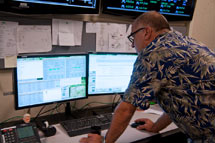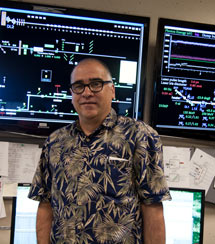
Handy Links
SLAC News Center
SLAC Today
- Subscribe
- Archives: Feb 2006-May 20, 2011
- Archives: May 23, 2011 and later
- Submit Feedback or Story Ideas
- About SLAC Today
SLAC News
Lab News
- Interactions
- Lightsources.org
- ILC NewsLine
- Int'l Science Grid This Week
- Fermilab Today
- Berkeley Lab News
- @brookhaven TODAY
- DOE Pulse
- CERN Courier
- DESY inForm
- US / LHC
SLAC Links
- Emergency
- Safety
- Policy Repository
- Site Entry Form

- Site Maps
- M & O Review
- Computing Status & Calendar
- SLAC Colloquium
- SLACspeak
- SLACspace
- SLAC Logo
- Café Menu
- Flea Market
- Web E-mail
- Marguerite Shuttle
- Discount Commuter Passes
-
Award Reporting Form
- SPIRES
- SciDoc
- Activity Groups
- Library
Stanford
Around the Bay
People: John Bozek's Opportunity of a Lifetime
Some people seem to be born knowing just what they want to do with their lives. Some people never figure out what they want to be when they grow up. SLAC Instrument Scientist John Bozek falls into a third category. When it came time to choose a career, he wasn't sure want he wanted, but he knew what he loved.
With that knowledge in mind, finding his place as the first instrumentation scientist of the Atomic, Molecular and Optical science instrument—the first user instrument at the Linac Coherent Light Source, the first hard X-ray laser—became a simple matter of following the fun.
Originally from Winnipeg, Canada, Bozek first studied pre-medicine because "that's what smart people did. Went into medicine." Bozek quickly learned he was not like the other smart people.
"I decided that was not my future because I liked discovering things too much, I liked investigating things too much," he said. Knowing medicine was out but not quite sure what would take its place, Bozek capitalized on all his chemistry courses and graduated with a degree in chemistry. "At least it was physical chemistry," he said with a laugh.
It was while Bozek was selecting a Ph.D. program that opportunity knocked for the first time. He received an offer from the University of Western Ontario to work at the Tantalus Synchrotron in Wisconsin, which was one of the first generation of synchrotrons.
"I fell in love with the hardware," Bozek said. "I've always been a mechanical guy; I like turning wrenches. I like fixing things. All that hardware, all the computers to interface to the hardware... just a lot of fun."
Bozek's philosophy of "follow the fun" continued to lead him true. He eventually joined Lawrence Berkeley National Laboratory to work on the Advanced Light Source. "I ended up at the Advanced Light Source just as it was turning on, and eventually started building instruments and then beamlines there. That gave me an entree to come in as the first instrument scientist at the LCLS."
Here, for a moment, his philosophy nearly failed him.
"When I was considering taking this job it was a difficult decision. I had a good job, a good career path at Berkeley Lab," he said.
The decision became much easier when he accepted one simple fact: "I would really be jealous of whoever got to do the first experiments here at the LCLS. And the only way I could be assured to be a part of that process was to be the guy who was building the instrument to do the first experiments here at the LCLS. We have an amazing opportunity to be the first people to do these experiments. It's really a privilege."
Bozek admitted the schedule has been rough. As the first LCLS instrument, the AMO was the sole focus of the unprecedented X-ray beam for months.
"For the first run we had beam every day, 24 hours a day. For this run we've had beam for twelve hours a day, almost every day." He paused. "What an honor to have this half-billion dollar machine pointed at your experiments for four months. Wow."
The LCLS has definitely captured Bozek's heart. ("The Undulator Hall is beautiful down there. I love it down there.") But the appeal goes beyond hardware.
"I work as hard as I do because I'm committed to the success of the LCLS and instrumentation," Bozek said. "But I'm not alone. The safety officer, the administrative assistants—everybody gives it their all. I've never run into anybody saying, 'No, I don't have time for that,' or 'No, it's not my job.' Everybody that I've talked with has a really strong sense of ownership for the success of the facility. It makes me feel good working hard knowing that everybody else is willing to give it their all, too."
Now that Bozek has found his place, he loves to share it with others. He's always up for giving a tour of the facility.
"It's really great to show this stuff off, the handiwork of all these people here, and try to impart that excitement about what it is we're doing here and how it works."
A recent beneficiary of his skills as a tour guide was Geoffrey Carr, science editor for The Economist. Bozek spent a couple of hours with Carr, showing him the Undulator Hall, the Beam Transport Hall, the control rooms, and the instruments. Carr did blog the experience, but Bozek's hopes for the encounter were not to be.
"One of the other dreams in my life was to be in The Economist magazine, and I came that close," he said wryly.
Bozek shrugged. "In the end, I'd rather turn wrenches."
—Lori Ann White
SLAC Today, August 11, 2010

